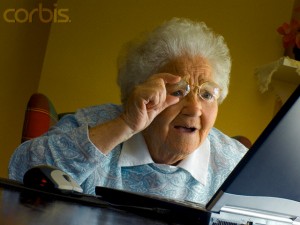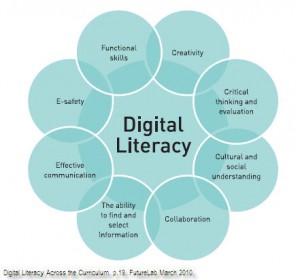While brainstorming ideas for how to start this online essay I glared into space, praying for some inspiration. Out the window to my right I noticed one of my Spanish classmates walking quickly, eyes glued to his IPhone. To my left, a table filled with unrecognizable faces hiding behind their matching Mac computers. In front of me, my own MacBook Air with a blank word document staring back at me. Behind me was a girl ferociously typing on her Dell laptop as if she were trying to punish her keyboard. At that moment, I decided to do an experiment. I explored the top two floors of the Waidner-Spahr library and recorded the number of students either on their phone or on their computer.
During the time I conducted this experiment, there were 71 students sitting at a desk in the library doing work. 63 of these students (88.7%) were either using a computer or on their phone, while 8 (11.3%) had no technology in front of them. These numbers were astonishing to me, but research has shown that these numbers are not new. Technology is now being used by nearly everyone. In a study conducted by the Pew Research Center, 78% of teens now have a cell phone, and almost half (47%) of those own smartphones. Nine in ten (93%) teens have a computer or have access to one at home.
Just because technology is being used by all of these teenagers, does not mean that they are digitally literate. ALA defines digital literacy as the ability to use information and communication technologies to find, evaluate, create, and communicate information, requiring both cognitive and technical skills. With all the statistics showing the current use of technology by todays generations, shouldn’t it be obvious to incorporate teaching digital literacy into the classroom?
In “No Longer a Luxury: Digital Literacy Can’t Wait” by Troy Hicks and Kristen Turner, the authors simply state that we are all citizens in a digital age. We are all on the roller coaster ride that is digital literacy, and we do not have the time or the luxury to question if we would like to partake. English teachers must actively commit to this digital rhetorical prospective on writing, or they will miss the opportunity to help their students engage effectively in the Information and Communication Technology (ICT) revolution taking place right now.
Hicks and Turner state, “We need todays students to critically consume information, to create and share across time and space, to cocreate and collaborate to solve problems, to preserve in light of setbacks, and to maintain flexibility (Hicks and Turner 58).” The authors state that becoming digitally literate will provide endless
 opportunities for the inquiries that will develop the skills stated above. Digital literacy, however, is more than just adding additional technology into the teaching we already do.
opportunities for the inquiries that will develop the skills stated above. Digital literacy, however, is more than just adding additional technology into the teaching we already do.
“We must have students use technology in ways that are truly digital. We should not simply have students find an image to insert into a slide deck; they should cite the source, remix the original image, and create their own image (Hicks and Turner 59).”
Digital literacy is all about learning functional skills to critically think and evaluate safely how to communicate, write, cite, and be original and creative online. A digitally literate individual needs to be able to not only find sources online, but properly cite the source and make the information their own. Having students cite a source, remix the original image, and create their own image is a recipe towards creating a more digitally literate student.
Why is digital literacy so important and how can we teach it?
In “Digital literacy as important as reading and writing” by Josie Gurney, Gurney quotes Mark Surman as saying, “Becoming literate in how the technical world works is equivalent to reading, writing, and the math’s. We need to look at this fourth literacy as
 mainstream (Gurney 1).” Sermon states that an individual that does not understand how the digital world functions, will be living in a
mainstream (Gurney 1).” Sermon states that an individual that does not understand how the digital world functions, will be living in a
world where they do not have the creative, innovative, and digital skills that are going to be needed in the future economy.
I personally hope to use the skills I am learning to help me with my future carer path. I have an interest in pursuing marketing and social media due to my desire to continue writing online and my ambition to be successful in business. Learning digital literacy is imperative to being prosperous because experts such as Martin Zwilling agree that understanding how to properly use technology has a colossal effect on those fields.
According to Zwilling, the businesses and the economy stated above are changing to become more digitally driven. Zwilling states in his article that we live in a “buyer-led digital age (Zwilling 1).”
This means that consumers are now using technology to change the way products are bought. A marketer that is digitally literate will understand how to use technology to create strategic digital marketing plans geared towards these consumers.
So if technology is so imperative in modern society, how should the education system teach this “fourth literacy”? Hicks and Turner put the burden on English teachers. “English teachers must embrace a new role: We must advocate for digital literacy, not just technology, in a way that reconceptualizes our discipline. We must dump the dittos, throw out the workbooks, and remix our teaching for a digital age (Hicks and Turner 61).”
Hicks and Turner describe five practices that destroy digital literacy:
- Counting Powerpoint Slides
- Using a blog without blogging
- Criticizing Digitalk
- Only asking students questions that can be answered through
 using a search engine.
using a search engine. - Using “cool” technology to deliver a planned lesson.
Rather than having students create a basic slideshow presentation with minimum requirements that need to be met, they should be able to create a presentation that requires more creativity. Secondly, blog is a verb not a noun. Many teachers use blogs to capitalize on the conversation aspects blogging offers, rather than using a blog to allow students to be creative and develop their own digital literacy.
Criticizing digitalk or “texting language” (BTW, Gr8, BRB, LOL, etc.) is also problematic. Texting language is tailored to the immediacy and compactness of new communication media outlets such as Facebook. Criticizing this “language” does not improve digital  literacy. “Research has shown that digitalk actually improves students’ linguistic competence and that adolescents develop an understanding of audience, purpose and voice in their digital writing communities (Hicks and Turner 61).”
literacy. “Research has shown that digitalk actually improves students’ linguistic competence and that adolescents develop an understanding of audience, purpose and voice in their digital writing communities (Hicks and Turner 61).”
Additionally, teachers that are only asking students questions that can be answered through a simple search “are not asking them to think critically or to use digital tools in substantive ways (Hicks and Turner 61).” Teachers need to help students by creating complex literacy tasks, which will inevitably create ideas that will build and refine over time, creating a more digitally literate student.
An example of this includes allowing students to create their own blog. This task stimulates creativity and grants students an opportunity to write, cite, and be engaged online.
The last practice that destroys digital literacy is using “cool” technology to deliver a planned lesson. Just because a tool might be flashy and seem like a substantial way to incorporate technology in the classroom, the most important aspect needs to be developing digital literacy.
So what even is digital literacy? The classic definition of literacy is the ability to read and write, but in Digital Literacy by Richard Lanham, he states that“the word literacy has gradually extended its grasp in the digital age until it has come to mean the ability to understand information, however it is presented (Lanham 1).” An individual that is literate in the digital world is a person whom is “well seen and well heard as well as well read, skilled deciphering complex images and sounds as well as the syntactical complexity of words (Lanham 1).”
Digital Writing
One aspect of a digital literacy is digital writing. Digital writing includes anything from a blog to a Facebook post, Tweet, Instagram, or even a Snapshat with a funky caption. Digital writing is any kind of writing that can be seen digitally. In “Consider the Audience” by Jen Rajchel, Rajchel states that writing on the web is more than simply writing for the web. “Web writing is also inherently about seeding the development of more opportunities to circulate work while still foregrounding the difficult navigation of the public/private that accompany them (Rajchel 3).”
Rajchel urges the importance of making a blog multimodal by incorporating images, videos, and links. While working on new media projects, Rajchel also follows a strict set of guidelines.
- What are the terms of service and do I feel comfortable with the amount of information I am sharing?
- Is this the audience I hope to be apart of?
- Is this medium adding a critical lens to the design of my argument?
Creating a blog is exactly the tool Hicks and Turner would recommend to stimulate digital literacy. A digitally literate individual needs to be able to not only find sources online, but properly site the source and make the information their own. A blog allows students to do precisely that.
Hicks and Turner also stated that students should “cite a source, remix the original image, and create their own image.” Since blogs are multimodal it additionaly will allow students to be creative with images. In my own blog ,written about my grandparents, I follow the steps that both Rajchel, Hicks, and Turner state about becoming more digitally literate.
I had to search the web for blogs similar to mine to find the audience I hoped to be a part of. I have to properly cite all images and resources I use, and most importantly I have to be creative. I have personally experienced blogging as being an exceptional tool towards increasing digital literacy.
My Experiences
A month prior to my first blog post, I had to first walk into my Writing in & For Digital Environments class. I was unsure about what I would learn and what the class would really entail. I registered for the class because I knew I liked to write and I knew I liked to write with little restrictions. The class description included that students would explore digital environments such as Facebook as well as learn the technical skills needed to create and maintain our own website/blog. I was ready.
I had little experience with online writing. I wouldn’t call middle school Facebook posts, retweets, Snapchats, and the occasional Instagram a resume for a digitally literate expert. I wanted to learn how our technologically advanced society has impacted writing, teaching, and learning. I wanted to learn how to be able to write online properly and add a new voice to the millions of voices posting every day.
In the first few months of class I have already had many in depth analytical discussions about how technology is changing the world with my classmates. I have learned how to properly create, manage, customize, and operate my own website. I have studied how to write a blog for a specific audience, make the blog multimodal, create a writing structure that is visually appealing, and so much more.
Digital writing classes teach students like me the importance of being able to think analytically and look at the world through a  different lens. I have learned to look up from my phone and watch what is going on, then write about it. As Ferris Buhler said, “Life
different lens. I have learned to look up from my phone and watch what is going on, then write about it. As Ferris Buhler said, “Life
moves pretty fast. If you don’t stop and look around once in a while, you could miss it.” Digital writing classes help students see the importance of that exact quote. I have learned to look around at my surroundings and take everything in. I explore the web and understand how it is contributing to my blog and how I can cite it. I look around the library and see my peers hiding behind their Mac computers.
When I now look at these heads in the library suppressed behind their computers, I wonder if they are digitally literate. So many of my peers know how to email, surf the web, download music, and take snapchats of cafeteria food, but are not digitally literate. Learning how to become digitally literate takes time. Taking a class on how to become digitally literate may take time, but it is well worth it.
In addition to learning how to write and correctly navigate online, this class will support me in accomplishing so much more. I am a Policy Major with an interest in marketing and business. Writing in & For Digital Environments allows me to explore how social media and online writing is changing the way businesses are managed. Marketing has expanded to nearly every website online. Marketing directors need to understand how to find target audiences online and create an advertisement that will appeal to that audience. Learning digital literacy is imperative.
Citations
Lanham, R. (1995). Digital Literacy. Scientific American.
Jen Rajchel, “Consider the Audience,” in Web Writing: Why and How for Liberal Arts Teaching and Learning, ed. Jack Dougherty and Tennyson O’Donnell (University of Michigan Press/Trinity College ePress edition, 2014), http://epress.trincoll.edu/webwriting/chapter/rajchel.
Hicks, T., & Turner, K. (2013). No Longer a Luxury: Digital Literacy Can’t Wait. English Journal, 102.6, 58-65.
Zwilling, M. (2015, October 20). 6 Critical Marketing Metrics To Target Todays Buyers. Retrieved October 22, 2015, from http://www.forbes.com/sites/martinzwilling/2015/10/20/6-critical-marketing-metrics-to-nail-todays-buyers/
Gurney-Read, J. (2013, November 11). Digital literacy ‘as important as reading and writing’ Retrieved October 22, 2015, from http://www.telegraph.co.uk/education/educationopinion/10436444/Digital-literacy-as-important-as-reading-and-writing.html
Mobile Technology Fact Sheet. (2013, December 27). Retrieved October 22, 2015.http://www.pewinternet.org/fact-sheets/mobile-technology-fact-sheet/
Images
http://4liberty.org.uk/wp-content/uploads/2015/09/kids-on-a-computer_0.jpg
http://workbench.cadenhead.org/media/ferris-bueller.jpg
https://cdn.psychologytoday.com/sites/default/files/blogs/45810/2010/11/51121-40993.jpg
https://carlytavares.files.wordpress.com/2014/11/any-languages-besides-texting.gif
http://www.mathiaspoulsen.com/wp-content/uploads/2010/05/digitalliteracy.gif

